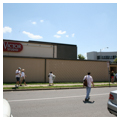Widely known as Music City, Nashville’s cultural landscape has been fundamentally shaped by the presence of a rich musical heritage. At the heart of this citywide musical pulse stands Music Row, a ten-block area that is dense with entertainment-related businesses. Music Row is home to a number of renowned establishments, including RCA Studio B and Owen Bradley’s Quonset Hut—places that gave birth to hits from luminaries like Elvis Presley and Dolly Parton. While the cultural legacy of Music Row is legendary, its physical landscape consists of an uninspired piecemeal collection of old houses and mid-century office buildings.
Prior to its identity as a linchpin in the music industry, Music Row was a residential neighborhood. Only a short distance from Nashville’s central business district, the neighborhood was originally developed to accommodate the city’s most prominent citizens. Two- and three-story Victorian residences toward the north end of the neighborhood housed Nashville’s doctors, university leaders, and railroad executives. Designed to communicate a sense of traditional wealth, brick sidewalks laid in a herringbone pattern led Nashville’s elite through a stately streetscape defined by wrought-iron fences and dotted with southern magnolias. Belmont Mansion served as the crown jewel of the neighborhood; loosely modeled on the villas of the Veneto, the house, with its commanding classical architecture, sits on a hilltop at the southern boundary of what is now Music Row. Built in 1849 under the vision of Adelicia Acklen, one of Nashville’s earliest celebrities, the mansion was purchased by Belmont College in 1887.
The southern portion of the original neighborhood was characterized by more modest bungalows and cottages. This area is adjacent to the Peabody Campus, now a part of Vanderbilt University. The original campus was built in 1874 on old farmland and housed Roger Williams University, one of four colleges for freed slaves established in Nashville after the Civil War. In 1905, two fires leveled the university’s most central buildings, and the school abandoned the campus. In 1914, Peabody College moved to the site. Peabody’s landscape is overtly classical, symmetrically delineated by rectangular lawns and straight allées. Evoking Thomas Jefferson’s University of Virginia, the Peabody campus reflects a northern effort to reshape the devastated southern landscape after the Civil War.
Despite its location between two established universities and proximity to the central business district, the neighborhood that later became Music Row languished during the first half of the twentieth century. After the Great Depression, in particular, when much of Nashville’s wealth disappeared, the area became much less prominent. It deteriorated further after World War II, when Nashville, like so many other cities, experienced dramatic suburbanization. At this point, the neighborhood became a quiet blue-collar community, one notable for its racial diversity, with modest houses and a few small businesses, including Goodhill’s Bakery and Foxall’s Pharmacy.
The neighborhood changed irrevocably when the country music industry boomed in the 1950s, prompting music executives to seek cheap office space close to downtown. One of these early pioneers was local legend Owen Bradley, who converted an old house on 16th Avenue into a recording studio. Bradley attached a Quonset hut to the back of the house for additional film and audio recording space, creating a site with mythic significance for country music lovers. Soon, music-related businesses flooded the neighborhood and the quiet, tree-lined residential streets became a bustling business corridor. Some establishments followed in Bradley’s footsteps and occupied existing houses, while others, such as RCA, constructed new mid-rise offices. The sudden density of entertainment enterprises—including recording studios, publicists, agents, and entertainment lawyers—catalyzed an inimitable culture of musical production that gave birth to the famous “Nashville sound.”
In 1967, the Country Music Hall of Fame purchased a portion of Tony Rose Park (named after a local musician and city councilman) and established a tourist attraction that brought a constant stream of visitors to Music Row. In response to heightened traffic through the corridor, the two residential streets comprising the spine of Music Row were converted to one-way thoroughfares in 1973.
After the Country Music Hall of Fame moved to downtown Nashville in 1996, Music Row struggled to establish an identity in its own right, at least as a cohesive built environment. While the area is still home to a host of music-related businesses, it is in transition from a landscape once centered on tourism. In 1999, Nashville commissioned the construction of the Music Row Roundabout to serve as gateway to Music Row and create a sense of place in the neighborhood, while also addressing traffic concerns and a lack of pedestrian infrastructure. The $3 million project features an artful use of masonry, with red, charcoal, and light gray pavers echoing the keys of a piano. The roundabout has earned a number of awards for the way it satisfies infrastructural needs while honoring musical culture in design moves both subtle and hyperbolic. In the center of the roundabout stands Musica, the largest group of bronze figures in the country. Local sculptor Alan LeQuire, who created the 42-foot statue of Athena housed in Nashville’s concrete replica of the Parthenon, crafted the grouping of five 16-foot figures exuberantly dancing as an attempt to embody Nashville’s musical sprit in physical form. While some residents condemned the figures’ full-frontal nudity, the sculpture certainly asserts itself as a local landmark.
Next to the roundabout is a small park that features brick and stone pavers constituting the paths, plazas, and low, curving walls that define the space. Named after Owen Bradley, the park opened in 1997, just months before his death. A bronze sculpture of a jovial Bradley sitting at a piano punctuates the park, inviting visitors to share his piano bench.
Music Row exemplifies the tension that arises when negotiating the priorities of a rich cultural history embodied within a nondescript physical landscape. The built environment of Music Row is remarkably lackluster, yet the creative accomplishments intrinsically linked to it became a global phenomenon. The current state of Music Row development is fraught with controversy. The midcentury office buildings that gave birth to some of the country’s most iconic music are being replaced by high-rise, mixed-use developments. Though this transformation has provoked a national and local outcry, the area never achieved historic designation protections because its buildings are neither old enough nor in good enough condition. Thus, activists seek other means to protect the landscape that nurtured the growth of the Nashville sound, while others envision a new wave of urban renewal for a neighborhood defined by continued revision.
References
Brookby, Sarah. “Leveraging the ‘Creative Class for Local Economic Development: Music Row in Nashville, Tennessee.” Master’s thesis, Georgia Institute of Technology, 2012.
Logsdon, Alva D. “Streetscape Delivers Landmark Appeal to Famous City.” Landscape Online. Accessed April 18, 2017. www.landscapeonline.com.
Kreyling, Christine. “Great Aspirations: Campus Architecture Reveals its Past and Informs its Mission.” Vanderbilt Magazine (2000): 22-23.
Kingsbury, Paul, ed. The Encyclopedia of Country Music: The Ultimate Guide to the Music. New York: Oxford University Press, 2004.























